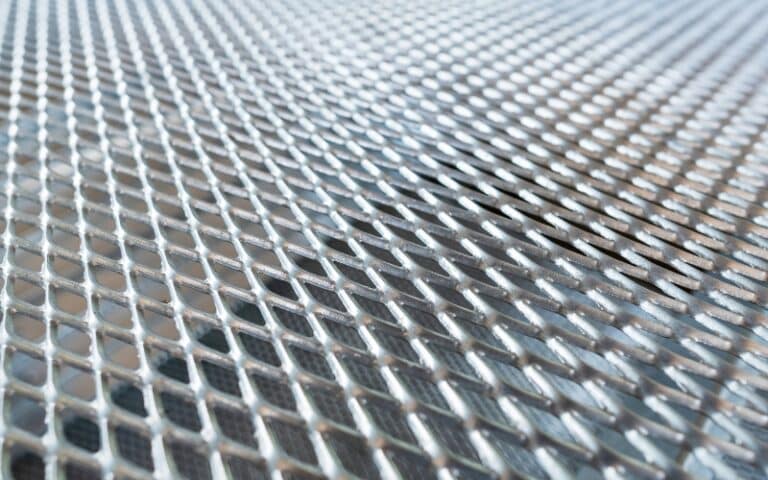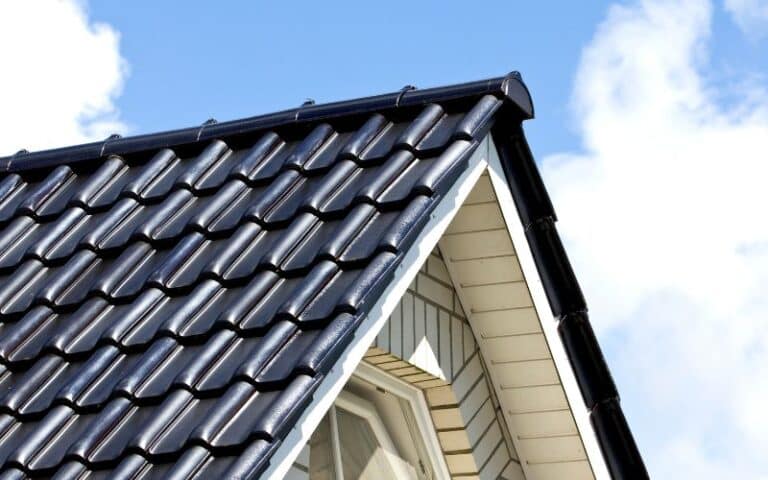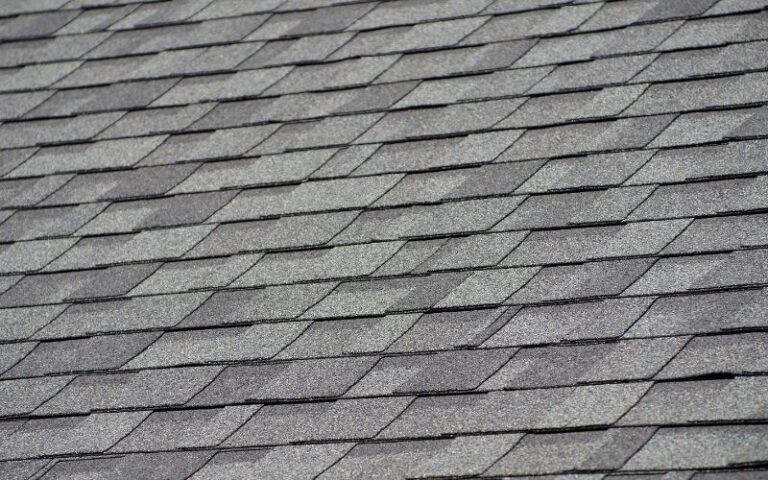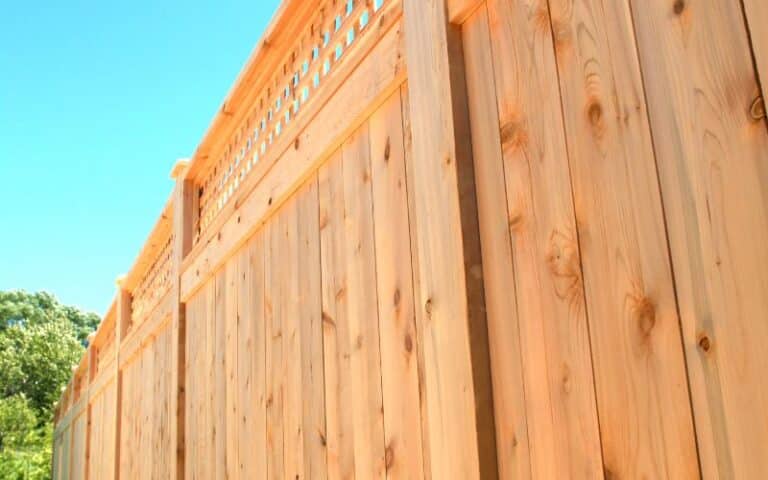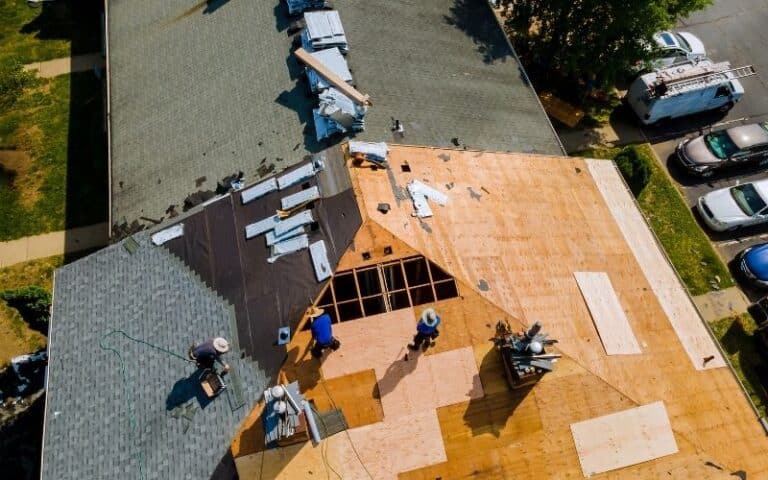The roof is an essential element of a building. It acts as a defense against environmental hazards and is available in different styles. The triangular roofs are also called Pitched Roof or Gable roofs.
The roof is known for its impressive benefits. The pitched roof comes in different kinds. They’re easy to maintain and relatively easy to construct. Many European homes have a triangular roof.
House Roofs are triangular because triangles are sturdy, perfect for rainwater drainage, and the steep slope restricts snow buildup. They’re also triangular because it improves energy efficiency in houses.
Ready for a Roofing Quiz?
Why Do Houses Have Triangular Roofs?

Over the years, triangular roofs have become the standard for classical home buildings. The roofs are perfect for the construction and interior of homes, which is why they’re the best option.
However, there are other reasons why houses have triangular roofs.
- Design: Triangular roofs have a traditional triangle-shaped design that some people like.
- Attic space: Attic space is for storing old stuff. Ceilings require ceilings to reduce moisture and prevent falls. Triangular roofs in home buildings will provide the best Attic space.
- Good surface area: Triangular Roofs have a wide slope. The more the roof surface area, the more rainwater, ice, and snow slide on the roof. Thus, it will prevent water damage to your home during heavy rainfall.
- Vaulted ceilings: with a triangular roof, it’s possible to have a vaulted ceiling in your home. It’s another reason people choose triangular roofs over other types of roofs.
- Protection from the sun: the roof’s triangle shape helps protect all parts of the roof – keeping the sun out. The protection from the sun will prevent heat buildup in the home buildings.
- Affordable: When compared to hip and flat roofs, triangle roofs are inexpensive and perfect for homeowners on a budget.
What Are Triangular Roofs called?
Triangular roofs are pitch roofs or Gable roofs. There are different gable roofs, but the essential Gable roof is a stepping stone for other pitched roofs.
Some basic Gable roofing materials include concrete clay tiles, cedar shingles, slate, and asphalt shingles.
The types of Gable roofs are a bit complex to build – Dutch Gable, side Gable, front Gable, and cross Gable.
All kinds of Gable roofs allow snow and ice to slide rather than accumulate on the roof surface.
However, it’s not advisable to use Gable roofs in areas with consistent hurricanes- to prevent wind damage to the top.
In Europe, Why Do They Build The Roof of A House Like A Triangle?
The logic behind using triangular roofs in houses in Europe is the same as in other regions. With a gabled roof, weathering conditions like rainfall and snow storms won’t damage the roof.
The sliding of snow, ice, and rain gives traditional triangle-shaped roofs an edge over roof styles.
However, it’s not the same for other roof styles, as there’s the tendency of a snow or water buildup which can leak into the house.
Hence, people using roof styles with gradual or low slopes might have to shovel off the snow during winter.
In Europe, the winter brings intense and heavy snowfalls, which is why gabled roofs are best for homes in the region.
Advantages of House Triangular Roof
#1. Energy saving
Triangular roofs are primarily in the mountain and cold regions. The triangular ridge or building envelope has cooling and healing effects that allow between 25-35% energy loss.
In addition, the roofs preserve energy with natural ventilation.
#2. Style & Construction
All the types of gabled roofs are from the essential top. The combined hips, valleys, and slopes give rise to the side, front, cross, and Dutch Gabled roofs.
Therefore, the architect can get creative and combine any gabled roof to construct a masterpiece.
The triangular roofs are thereby standard in remote areas because of the ease of construction.
Meanwhile, onlookers can check out the building from below ground, unlike flat roofs, which aren’t visible.
#3. Protection From Harsh Weather Conditions
Triangular roofs are solid and stable and ensure adequate water drainage. In addition, the roofing tiles are waterproof and rugged – thus, the top is to withstand harsh weather conditions.
#4. Inexpensive
Gable roofs are pretty affordable to construct – compared to other roof styles like a hip roof.
However, the difference between Gable and hip roofs is that all the sides of the hip roof slope downwards and have no gables.
#5. Less Maintenance
The two sides of the triangular roof firm a central ridge and slope downwards, preventing stagnant ice, snow, and water from damaging the house.
Thus, the traditional triangle roof requires less maintenance- though you can’t say the same for roofs with low slopes.
On the other hand, the occasional snow or water buildup will require substantial maintenance costs – thus, making you spend more to increase your home lifespan.
#6. Ventilation
The space between the Gable roof and the interior allows ventilation, removing hot air during summer and damp air during winter. It’d be better to add a ventilation tower to the triangular roof while constructing.
#7. Solar Panels
Solar panels help generate electricity which will reduce your electricity bills – hence, it’s necessary to position them correctly.
It’s easier to install solar panels on triangular roofs because they have the required angle.
The solar panels will increase your roof lifespan, protect it from weather elements and improve the energy efficiency in your home.
#8. Thermal Mass
Houses with triangular roofs have less surface exposed to weather elements.
Thus, a small building is equivalent to a high thermal mass which will keep the home at a consistent and comfortable temperature.
#9. Additional space
The pitched roof makes space for extra rooms beneath them. You can construct an attic or use a vaulted ceiling to use the area.
#10. Rainwater
With the triangular roof, you can collect rainwater. The rainwater passes into the external drainage system, which is easier to maintain than flat roof drainage.
Besides, the components of some triangular roof tiles, like natural slates, have no harmful effects on the water.
Why Do Houses Tend Triangular Roofs, whereas Office Buildings Have A Flat Roof?
Here are the reasons some houses have triangular roofs, and office buildings have flat roofs.
#1. Height
Office buildings have several units meaning the building gas to be large- and architects have to maximize the height.
Since the roof is the height, it’s essential to use flat roofs, which will allow additional floors with other office units.
#2. Appliances
Appliances like AC condensers are usually at the ground level in home buildings.
However, office buildings will use many AC condensers, so they might not have adequate space. Therefore, installing the air handling units on the roof is suitable.
#3. Roof Design
House buildings are often low, so having an excellent triangular roof design is a plus. It’s not the case for office buildings as they’re pretty higher.
Buildings of about 6-8 stories tall buildings are better off with flat roofs because you won’t see the top unless you’re far away from it. Using a pitched roof might be a waste.
Final Thoughts
Triangular roofs are standard in home buildings. Many choose them because they have advantages over other roof styles, including lower construction and maintenance costs.
These roofs also provide better ventilation. They’re also called pitched roofs or gable roofs.

